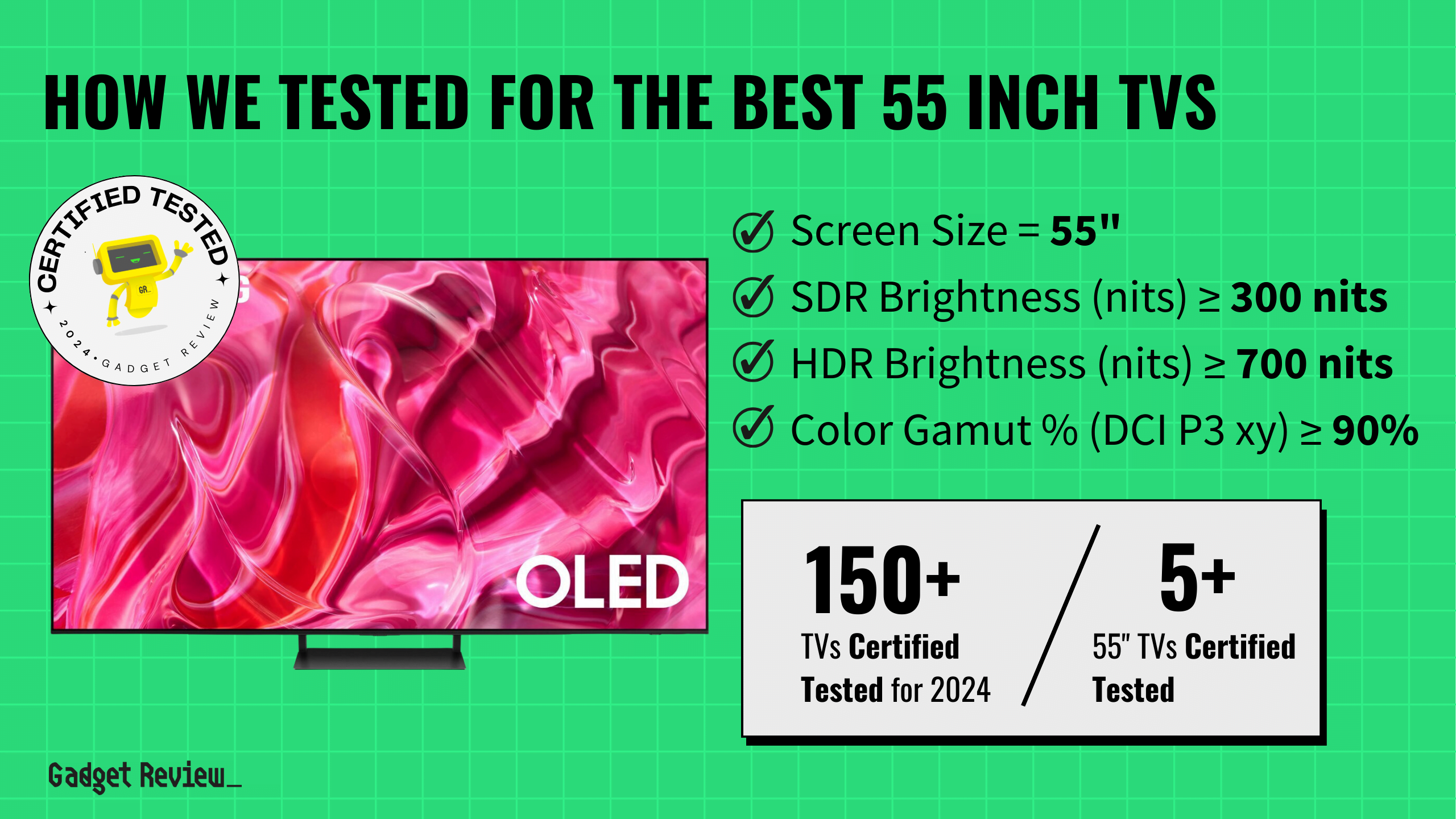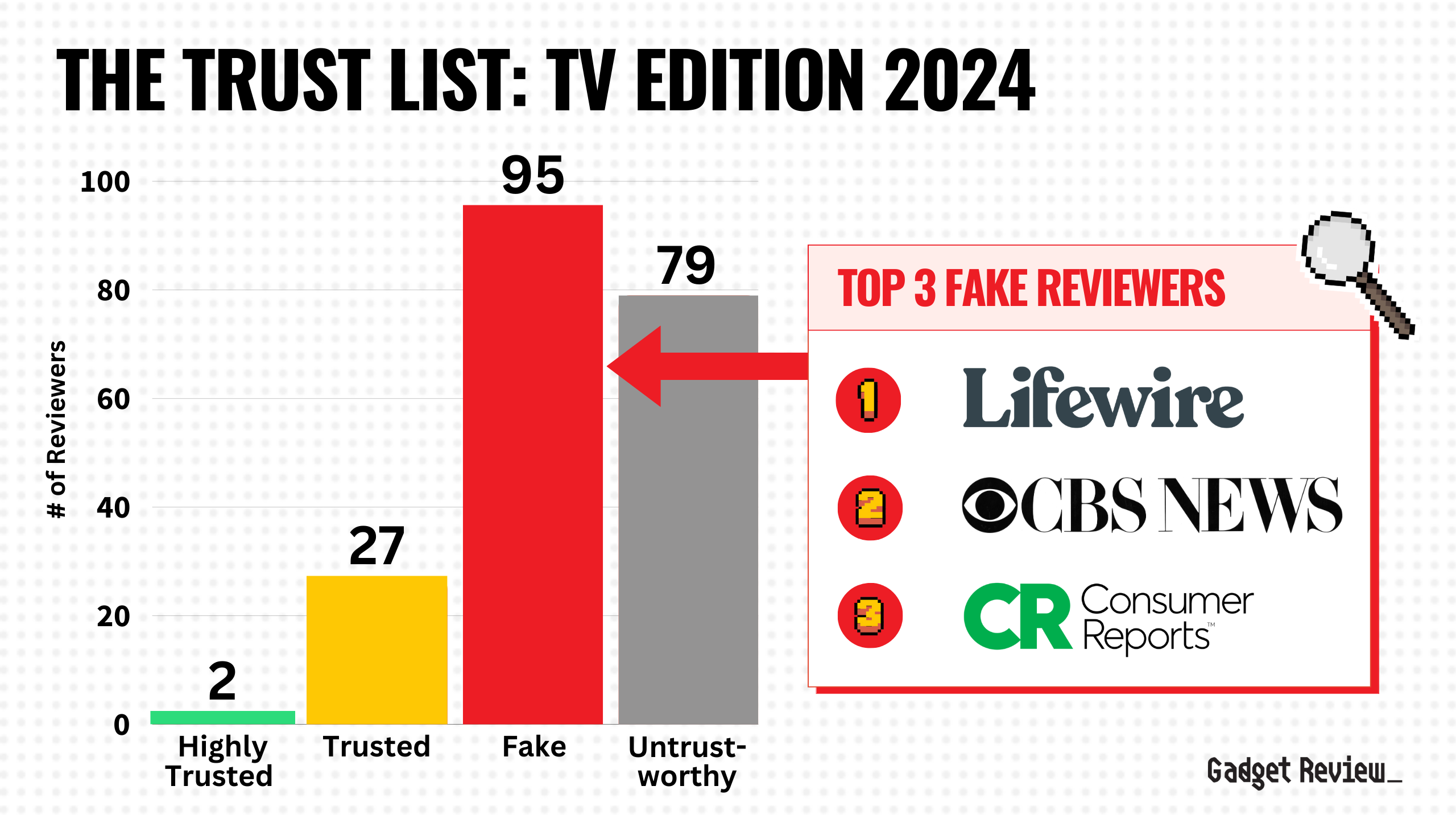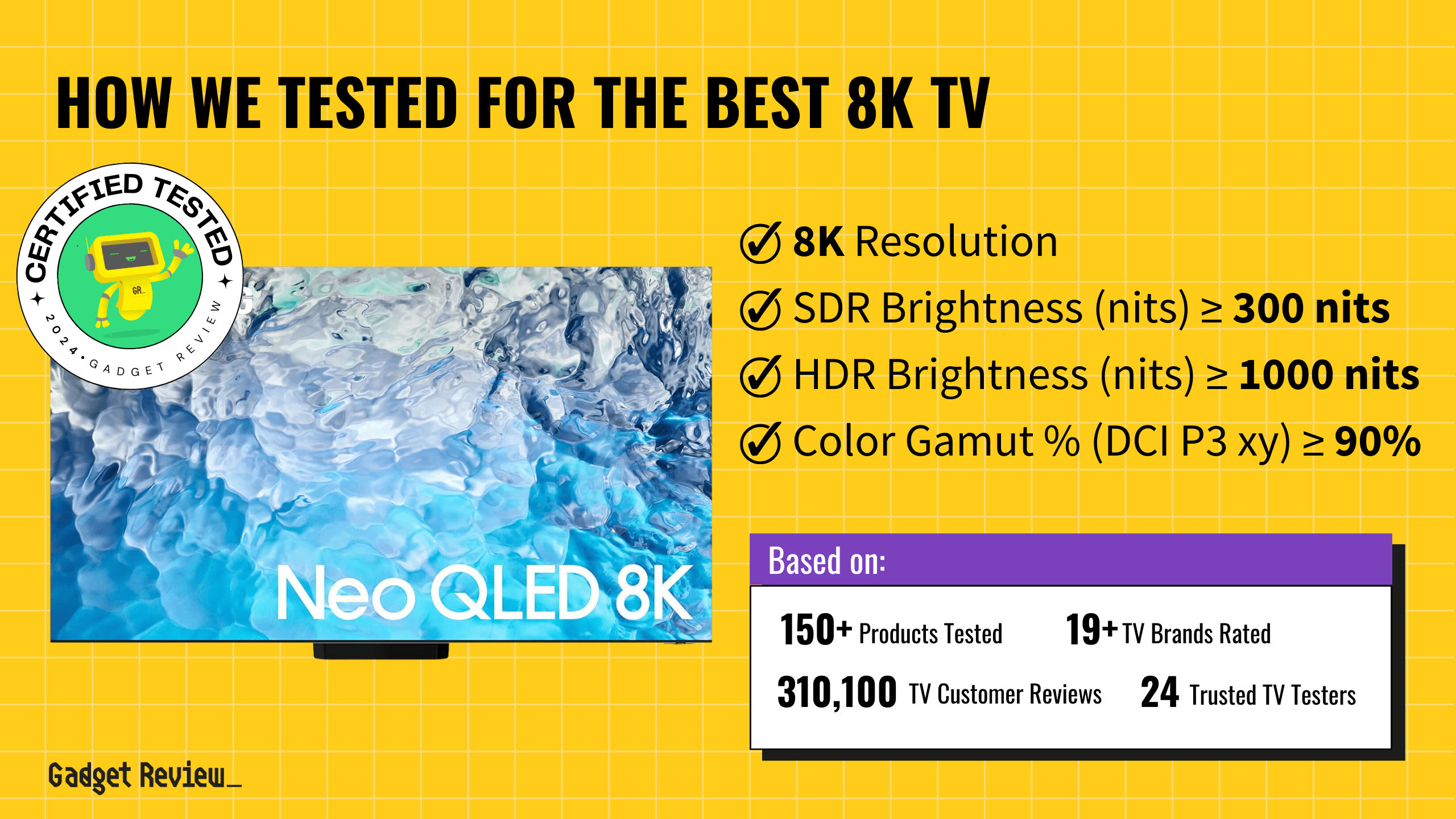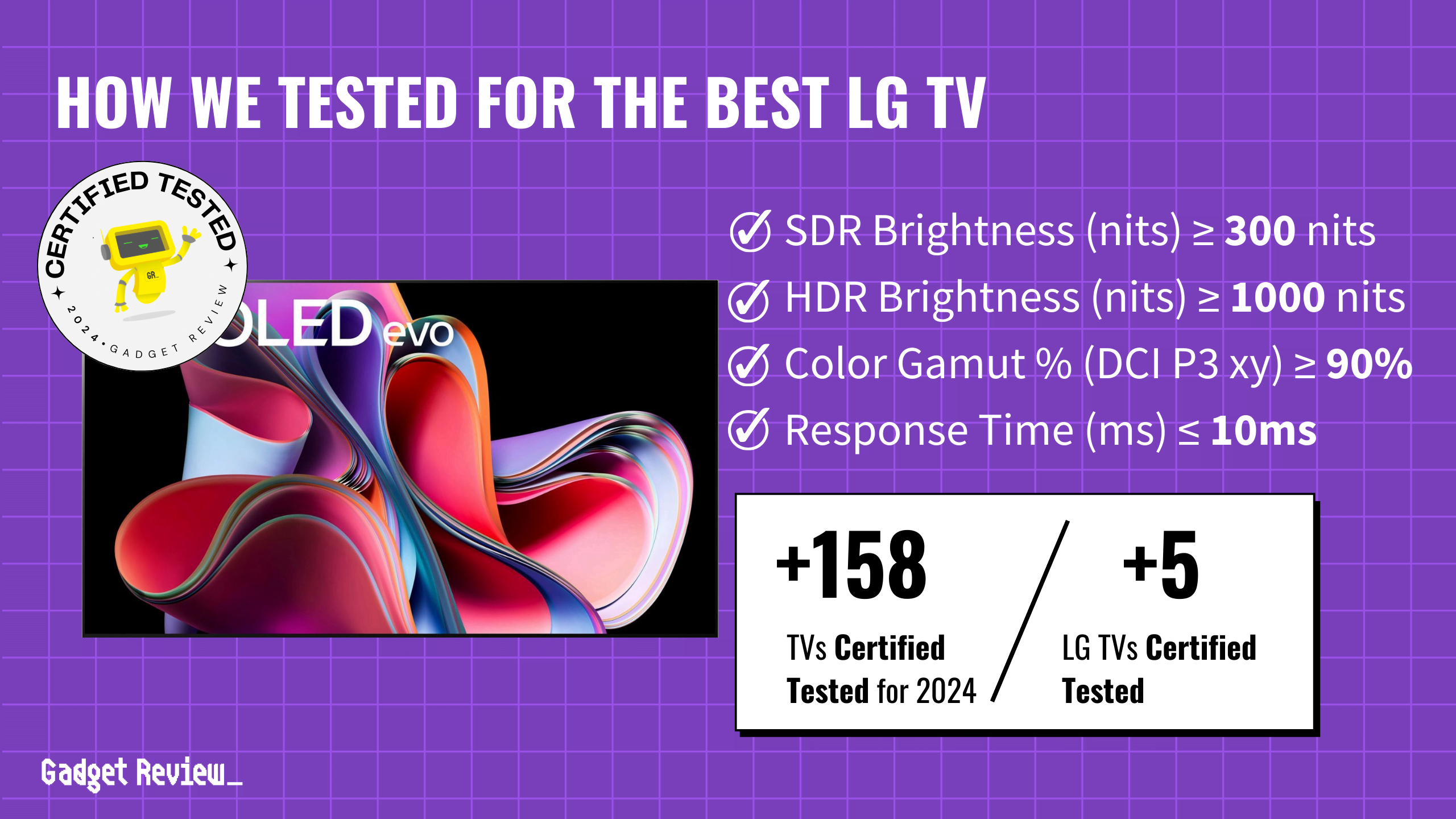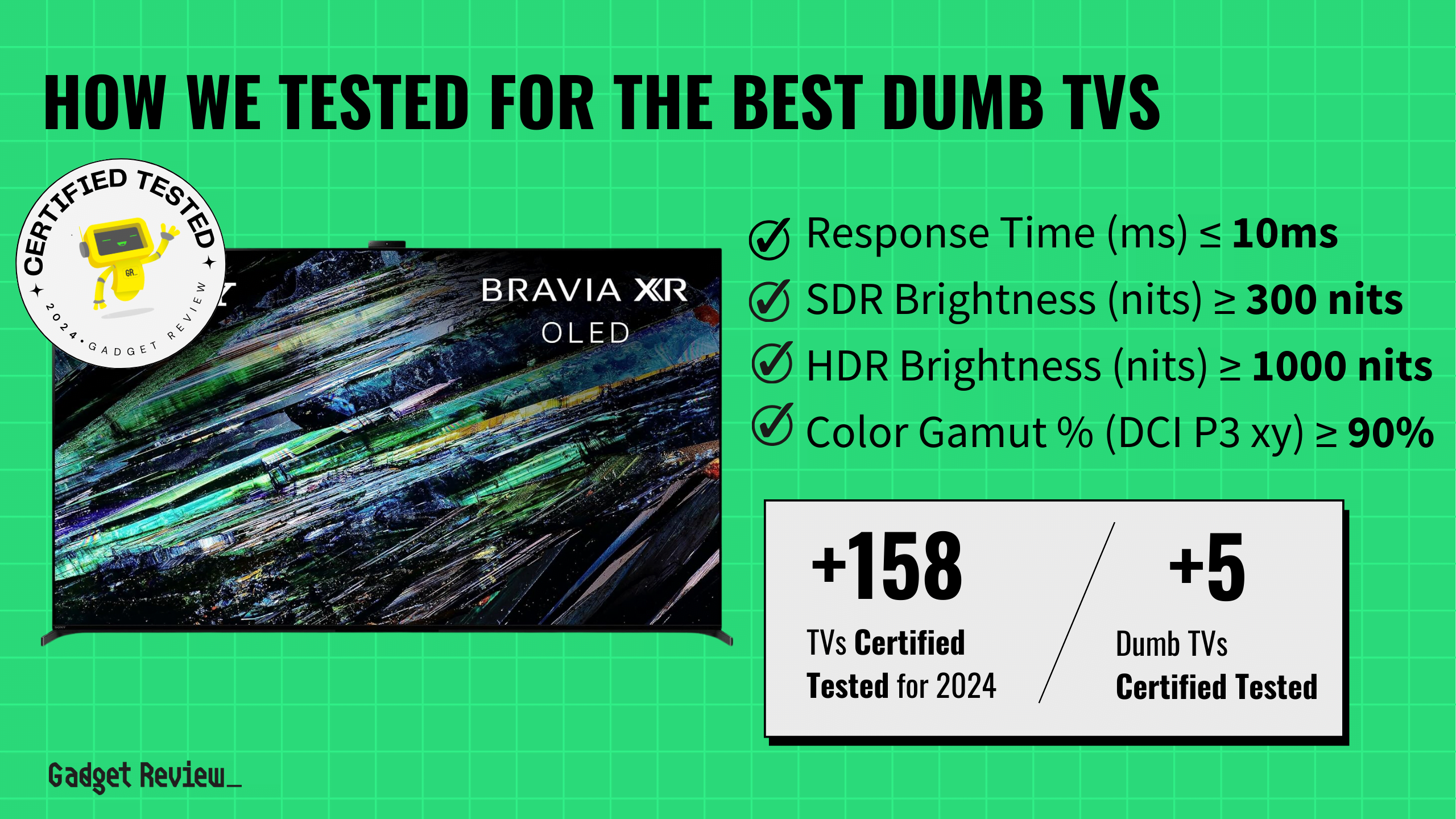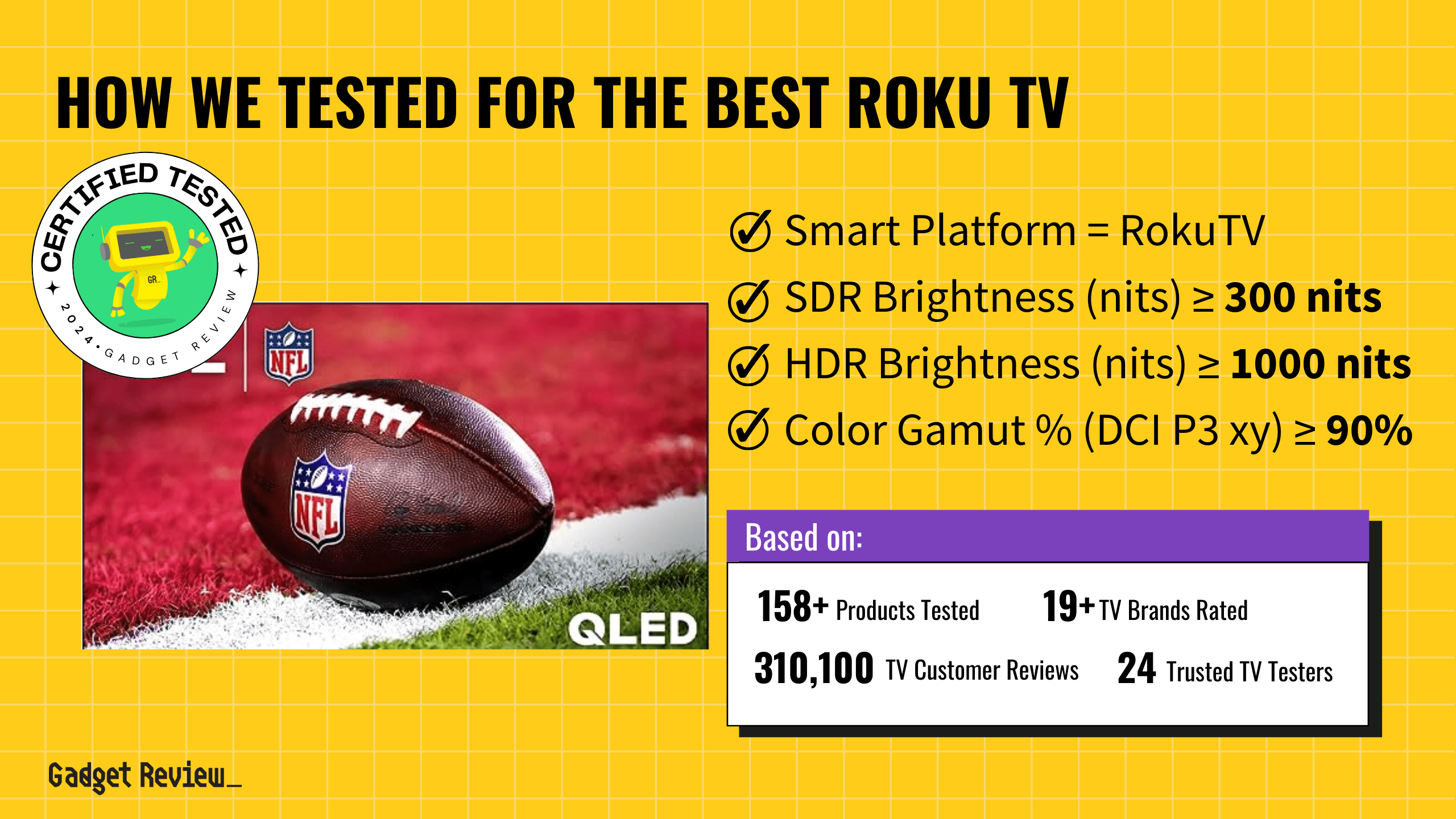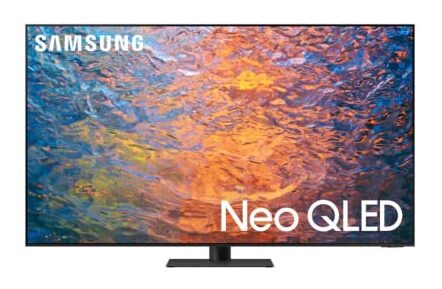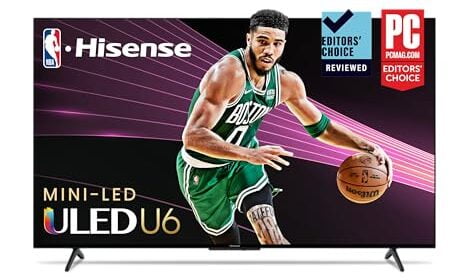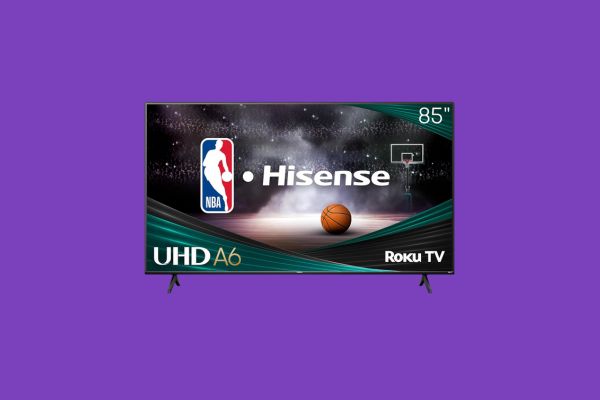While the best 55-inch TVs may not be the most popular size anymore, they strike an excellent balance between an immersive viewing experience and fitting well in smaller rooms. We’ve covered a wide price range to ensure you find a top-rated TV model that fits your budget, from budget-friendly options to premium models, all supported by thorough test data.
Whether you’re on a tight budget or in search of advanced features, you’ll find a 55-inch TV that gives you both quality and value.
How Did We Rank the Best 55 Inch TVs?
To assess how high or low quality a TV actually is 55 Inch TVs, one must evaluate specific testing criteria against reference industry standards. Using our thorough TV Testing Methodology, we determined there are 1 minimum specs and 6 criteria below (3 required, 3 nice to have) that ensure your 4K content looks as good as the creator intended it.
?️ Minimum Specifications
- Screen Size: 55 inches, delivering an immersive viewing experience.
? Test Criteria
- SDR Brightness: Greater than or equal to 300 nits, ensuring clarity in standard dynamic range content.
- HDR Brightness: 700 nits or higher, revealing intricate details in high dynamic range scenes.
- Color Accuracy: Achieving a minimum of 90% DCI P3 coverage for accurate and vibrant colors.
? “Nice To Haves”
- Contrast Ratio: Exceeding 10,000:1, providing striking differentiation between light and dark.
- EOTF Accuracy: Maintaining a delta of 0.018 or less for precise brightness levels in HDR content.
- Fast Response Time:Less than or equal to 10ms, ensuring smooth transitions for fast-paced action sequences.ur.
We’ve redefined TV buying guides, setting us apart from any other site on the planet. Our unique approach combines in-house verification with a comprehensive dataset from over 200+ trusted sites, focusing on key testing metrics to rank the top rated TVs. Testing data and specs include brightness (300 nits and 700 nits), Minimum 90% DCI P3 color gamut, and a set that is 55″. In this case, it’s for 55-inch TVs, delivering exceptional performance in various lighting conditions and providing an immersive viewing experience without compromising on space. Discover our data-driven methodology for precise, reliable TV recommendations.
Latest Updates
- 03/06/2024: Completely and thoroughly overhauled the guide to include the best and latest TVs.
- 11/30/2023: Republished the list to include TVs based on our True Score system.
Our commitment to unbiased reviews is powered by our ‘True Score’ system, targeting low quality and fake reviews. Commissions fund this mission. No bias. No BS.
Top Best 55 Inch TVs For 2025
Prices accurate at the time of publishing
To make our list, a 55-inch TV must be 55 inches and have great picture quality with a minimum brightness of 300 nits for SDR and 700 nits for HDR. If it falls short, it’s out!

Best Overall

Runner Up

Best Value

Best Budget

Best Mid-Range

Premium Pick
Samsung S90C TV
The ultimate 55-inch TV choice for those who prioritize exceptional performance and value, delivering nearly infinite contrast, superior viewing angles, and top-notch color accuracy.
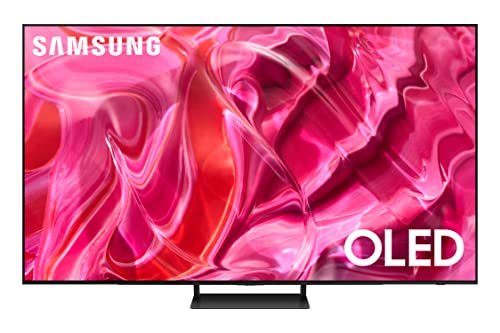
True Score
92948Experts
925kCustomers
Cosmic Wonder
 SAVE $197$1,295.00$1,097.95
SAVE $197$1,295.00$1,097.95Snapshot
Reasons to Buy
- Excellent picture quality
- The near-infinite contrast ratio for perfect blacks
- High peak brightness
- Exceptionally wide viewing angle
- Low input lag/Response time
- Sharp upscaling
Reasons to Avoid
- Aggressive Auto Brightness Limiter (ABL)
- No support for DTS or Dolby Vision
Specifications
Max Resolution 3840 x 2160 (4k) 
Backlight Type n/a Refresh Rate 120 Hz, 144 Hz Display Type OLED HDMI Inputs 4 
HDMI Type HDMI 2.1 HDR Format HDR10+, HLG 
HomeKit Compatible No 
Number of Audio Channels 2.1 
Panel Type OLED Screen size 55″, 65″, 75″, 83″ 
Smart Platform Tizen 
Speaker Output 40 Watts 
Sync Technology AMD FreeSync Premium 
VRR Yes All Specs
Test Results
SDR Brightness (nits) 373 HDR Brightness (nits) 1,058 Color Gamut % (DCI P3 xy) 99.975 Response Time (ms) 1.4 Contrast Ratio (x:1) 0 EOTF (600 nit delta) 0.0031 Color Gamut % (DCI P3 uv) 99.95 Color Gamut % (Rec 2020 xy) 86.37 Color Gamut % (Rec 2020 uv) 91.59 Color Gamut % (sRGB) 0 Color Gamut % (Rec 709) 0 Color Gamut % (BT.2020) 76 Color Gamut % (Adobe RGB) 0 Color Gamut % (BT.709) 0 Input Lag (ms) 8.5 Color Washout (Degrees) 70 Color Shift (Degrees) 70 Brightness Loss (Degrees) 70 Reflections (%) 1.2 Low-Freq Extension (Hz) 84.76 Freq Response StdDev @ 70db 2.8 Freq Response StdDev @ 80db 3.63 Weighted Total Harmonic Distortion @80db 0.133 Intermodulation Distortion @80db 2.47 EOTF (1000 nit delta) 0.0036 EOTF (4000 nit delta) 0.0024 All Tests
All Retailers
- $1,097.95$1,295Save $197
Availability
In StockFree Shipping
No - $1,149.00$1,500Save $351
Availability
In StockFree Shipping
No - $1,399.99$1,600Save $200
Availability
In StockFree Shipping
No
Our Verdict
The Samsung S90C offers tremendous value and exceptional performance, easily securing a spot on our list and offering up incredible performance at a fantastic price. Thanks to its OLED panel, the S90C delivers nearly infinite contrast and exceptional viewing angles, both of which are further served by its best-in-class color gamut coverage of 99.98%.
While its SDR and HDR brightness (373 nits and 1058 nits, respectively) lag behind some of the brighter OLEDs on this list, it still provides enough brightness to produce a vivid picture in moderately lit rooms with minimal reflections. Its best-in-class 1.4 ms response time also cements it as an outstanding choice for sports fans looking for fast action with no blurring.
If you’re looking to get the most out of your games, the S90C’s 8.5 ms input lag also makes the TV an excellent option for competitive gamers seeking immediate response without sacrificing visual fidelity. The TV also features an EOTF of 0.0031, which puts it high in the rankings for overall gamma tracking and makes the TV an excellent choice as a home theater centerpiece.
Whether for gaming, movies, or sports the S90C stands out as a top-tier choice in the 55-inch category, capable of meeting nearly any challenge you can throw at it outside of extremely bright rooms.

Best Overall

Runner Up

Best Value

Best Budget

Best Mid-Range

Premium Pick
Samsung S95C OLED TV
A premium option with unmatched color accuracy and brightness, ideal for varied lighting conditions and demanding gamers, offering flexibility and high-end performance at a premium.
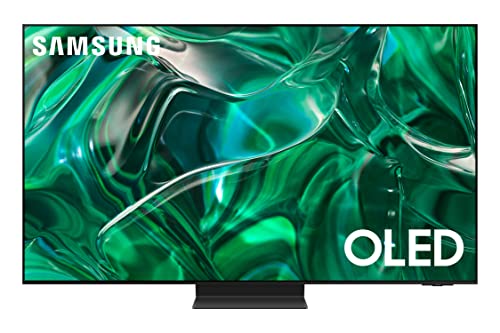
True Score
899215Experts
90724Customers
Absolutely Fresh
 $1,379.00
$1,379.00Snapshot
Reasons to Buy
- Excellent image quality
- Produces great bright colors and deep blacks
- Exceptionally wide viewing angle
- Incredibly low input lag
Reasons to Avoid
- Aggressive ABL
Specifications
Max Resolution 3840 x 2160 (4k) 
Backlight Type No Refresh Rate 120 Hz, 144 Hz Display Type OLED HDMI Inputs 4 
HDMI Type HDMI 2.1 HDR Format HDR10+, HLG 
HomeKit Compatible No 
Number of Audio Channels 4.2.2 
Panel Type QD-OLED Screen size 55″, 65″, 77″ 
Smart Platform Tizen 
Speaker Output 70 Watts 
Sync Technology AMD FreeSync, AMD FreeSync Premium Pro 
VRR Yes All Specs
Test Results
SDR Brightness (nits) 704 HDR Brightness (nits) 1,383 Color Gamut % (DCI P3 xy) 99.81 Response Time (ms) 5.5 Contrast Ratio (x:1) 0 EOTF (600 nit delta) 0.0029 Color Gamut % (DCI P3 uv) 99.53 Color Gamut % (Rec 2020 xy) 84.99 Color Gamut % (Rec 2020 uv) 89.78 Color Gamut % (sRGB) 0 Color Gamut % (Rec 709) 141.5 Color Gamut % (BT.2020) 75 Color Gamut % (Adobe RGB) 0 Color Gamut % (BT.709) 0 Input Lag (ms) 8.3 Color Washout (Degrees) 70 Color Shift (Degrees) 70 Brightness Loss (Degrees) 70 Reflections (%) 1 Low-Freq Extension (Hz) 106.79 Freq Response StdDev @ 70db 2.45 Freq Response StdDev @ 80db 2.41 Weighted Total Harmonic Distortion @80db 0.511 Intermodulation Distortion @80db 0.511 EOTF (1000 nit delta) 0.0025 EOTF (4000 nit delta) 0.0022 All Tests
All Retailers
- $1,379.00
Availability
In StockFree Shipping
No - $1,387.95$2,198Save $810
Availability
In StockFree Shipping
No - $1,499.99$1,900Save $400
Availability
In StockFree Shipping
No
Our Verdict
The Samsung S95C is one of the best options on our list thanks to its fantastic color accuracy and brightness, boasting a 99.81% DCI P3 color gamut and peak brightness levels that make visuals pop in any lighting condition. With a SDR and HDR brightness of 704 and 1383 nits respectively, it’s best-in-class for brightness among the OLED panels on our list. This means it’s perfect for both dark home theaters and bright rooms.
If you’re a sports fan and looking for an OLED bright enough to set up in a bright room, its 5.5 ms response time is solid enough for keeping the action blur-free while being bright enough to deal with sunlight. Fortunately for gamers, the 8.3 ms input lag is best-in-class, making the S95C a phenomenal choice for anyone looking to get every edge they can in a competitive environment.
Thanks to the S95C’s excellent EOTF performance, also best-in-class at 0.0029, the TV is more than capable of displaying home theater content with fantastic accuracy in any context, bright or dark. This makes the S95C an exceptionally flexible option, capable of handling anything that comes its way as long as you’re willing to pay, because it’s among the most expensive options on our list too.

Best Overall

Runner Up

Best Value

Best Budget

Best Mid-Range

Premium Pick
LG B3 OLED TV
The budget-friendly OLED option that defies its price with exceptional contrast, wide viewing angles, and vibrant visuals, making it a smart pick for those seeking OLED quality without the premium cost.
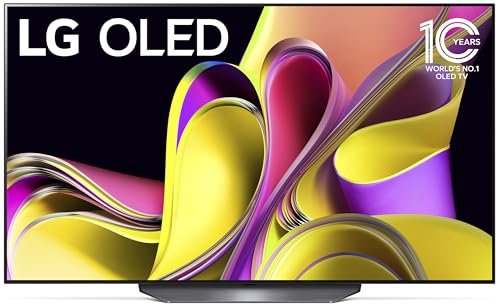
True Score
89874Experts
922kCustomers
Absolutely Fresh
 SAVE $417$1,296.99$879.99
SAVE $417$1,296.99$879.99Snapshot
Reasons to Buy
- Excellent picture quality
- Great Contrast
- High-performance motion handling
- Fast refresh rate
- Wide Viewing Angles
Reasons to Avoid
- Below Average Brightness
- Aggressive ABL
- Mediocre speaker sound quality
Specifications
Max Resolution 3840 x 2160 (4k) 
Backlight Type n/a Refresh Rate 120 Hz Display Type OLED HDMI Inputs 4 
HDMI Type HDMI 2.1 HDR Format Dolby Vision 
HomeKit Compatible Yes 
Number of Audio Channels 2.1 
Panel Type OLED Screen size 55″, 65″, 77″ 
Smart Platform webOS 
Speaker Output 20 Watts 
Sync Technology AMD FreeSync Premium, G-Sync 
VRR Yes All Specs
Test Results
SDR Brightness (nits) 390 HDR Brightness (nits) 617 Color Gamut % (DCI P3 xy) 98.345 Response Time (ms) 3.1 Contrast Ratio (x:1) 0 EOTF (600 nit delta) 0.0067 Color Gamut % (DCI P3 uv) 99.62 Color Gamut % (Rec 2020 xy) 73.09 Color Gamut % (Rec 2020 uv) 77.66 Color Gamut % (sRGB) 0 Color Gamut % (Rec 709) 0 Color Gamut % (BT.2020) 73.14 Color Gamut % (Adobe RGB) 0 Color Gamut % (BT.709) 0 Input Lag (ms) 11.7 Color Washout (Degrees) 64 Color Shift (Degrees) 31 Brightness Loss (Degrees) 70 Reflections (%) 1.4 Low-Freq Extension (Hz) 84.76 Freq Response StdDev @ 70db 3.64 Freq Response StdDev @ 80db 3.67 Weighted Total Harmonic Distortion @80db 0.165 Intermodulation Distortion @80db 8.25 EOTF (1000 nit delta) 0.0035 EOTF (4000 nit delta) 0.0037 All Tests
All Retailers
- $879.99$1,297Save $417
Availability
In StockFree Shipping
No - $1,196.99$1,697Save $500
Availability
In StockFree Shipping
- $1,199.99
Availability
In StockFree Shipping
No - $1,349.00$1,700Save $351
Availability
In StockFree Shipping
No
Our Verdict
If you’re looking for a more budget friendly option while still getting the benefit of OLED’s infinite contrast and extreme viewing angles, the LG B3 provides performance that defies its price point. Its OLED technology delivers exceptional contrast and wide viewing angles, critical for an immersive viewing experience, and the B3 excels in delivering vibrant visuals thanks to its 98.35% DCI P3 color gamut coverage.
Brightness levels are more than adequate for typical settings, with SDR and HDR brightness at 390 and 617 nits respectively. While these figures might not top the charts, they ensure the B3 performs well enough in moderately lit environments, but it’s definitely not intended for bright rooms.
Its excellent response time of 3.1 ms stands out – second-best in its class and beaten only by its more expensive brother, the C3. The snappy response times makes the B3 well suited to delivering fast-paced sports content and action movies with minimal blur. The 11.7 ms input lag, on the other hand, is middling, but solid enough for casual gaming, which combines well with the response time and 120 Hz refresh rate to make intense moments come across clear and tear-free.
Overall, the LG B3 offers a compelling mix of features for its price. Its strengths in color accuracy, response time, and adequate brightness make it a versatile choice suitable for a variety of viewing scenarios for anyone that’s on a budget. It’s not the Best Value TV on the list overall, but it is the best choice you can make if you’re looking for OLED performance without paying OLED premiums.

Best Overall

Runner Up

Best Value

Best Budget

Best Mid-Range

Premium Pick
LG C3 OLED TV
A step up from the B3, the C3 offers enhanced performance across the board, ideal for those looking for a mix of high-end OLED features and responsiveness at a slightly more accessible price point.
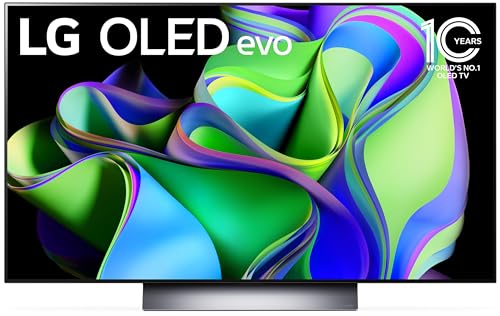
True Score
88879Experts
9312kCustomers
Absolutely Fresh
 SAVE $143$1,236.99$1,094.00
SAVE $143$1,236.99$1,094.00Snapshot
Reasons to Buy
- Excellent picture quality
- The near-infinite contrast ratio for perfect blacks
- Strong peak brightness
- High-performance motion handling
- Fast refresh rate
Reasons to Avoid
- Aggressive automatic brightness limiter
- Subpar sound quality
Specifications
Max Resolution 3840 x 2160 (4k) 
Backlight Type No Refresh Rate 120 Hz Display Type OLED HDMI Inputs 4 
HDMI Type HDMI 2.1 HDR Format Dolby Vision, HDR10, HLG 
HomeKit Compatible Yes 
LED Panel Type WOLED 
Number of Audio Channels 7.1.2 
Panel Type – Screen size 42″, 48″, 55″, 65″, 75″, 83″ 
Smart Platform webOS 
Speaker Output 20 Watts 
Sync Technology AMD FreeSync Premium, G-Sync 
VRR Yes All Specs
Test Results
SDR Brightness (nits) 383 HDR Brightness (nits) 795 Color Gamut % (DCI P3 xy) 98.98 Response Time (ms) 2.3 Contrast Ratio (x:1) 0 EOTF (600 nit delta) 0.0056 Color Gamut % (DCI P3 uv) 99.51 Color Gamut % (Rec 2020 xy) 73.28 Color Gamut % (Rec 2020 uv) 76.01 Color Gamut % (sRGB) 0 Color Gamut % (Rec 709) 0 Color Gamut % (BT.2020) 74.7 Color Gamut % (Adobe RGB) 0 Color Gamut % (BT.709) 0 Input Lag (ms) 9.6 Color Washout (Degrees) 63 Color Shift (Degrees) 34 Brightness Loss (Degrees) 70 Reflections (%) 1.1 Low-Freq Extension (Hz) 80 Freq Response StdDev @ 70db 1.14 Freq Response StdDev @ 80db 1.98 Weighted Total Harmonic Distortion @80db 0.085 Intermodulation Distortion @80db 4.49 EOTF (1000 nit delta) 0.0054 EOTF (4000 nit delta) 0.0051 All Tests
All Retailers
- $1,094.00$1,237Save $143
Availability
In StockFree Shipping
Yes - $1,099.00$1,998Save $899
Availability
In StockFree Shipping
No - $1,396.99$1,797Save $400
Availability
In StockFree Shipping
- $1,399.99
Availability
In StockFree Shipping
No
Our Verdict
If you’re looking for a step up from the B3, the LG C3 is basically a slightly more expensive version of it that offers better performance overall across the board. It covers 98.98% of the DCI P3 color gamut, keeping colors true to life, and like other OLED panels on this list, features excellent viewing angles (63 degrees before color starts to wash out) and exceptional reflections handling (1.1% total light reflected.)
Though its brightness levels, with SDR at 383 nits and HDR at 795 nits means the C3 can’t deal with brightly lit rooms, it’s got ample brightness for most home viewing scenarios, providing clear and vivid images without the need for a pitch-dark room. Unlike the B3, which will struggle in some of the brighter parts of the home, the C3 can deliver HDR content in slightly more well lit spaces without becoming overwhelmed.
A key highlight is its response time of 2.3 ms, making fast-moving images crisp and clear with minimal blur, and making the C3 ideal for any sports fan or action movie buff. The TV also boasts a respectable input lag of 9.6 ms, making it a solid choice for competitive gamers seeking a balance between high-end display quality, gameplay responsiveness, and overall value.
The C3 is, overall, an excellent option for anyone looking for top-notch color accuracy, great contrast, and fast response times in a more affordable package. Whether you’re watching your favorite films, binge-watching series, or diving into video games, the C3 delivers a quality experience that’s hard to beat in the 55-inch TV segment.

Best Overall

Runner Up

Best Value

Best Budget

Best Mid-Range

Premium Pick
Hisense U7K
The best value champion, combining respectable color accuracy, adequate brightness, and responsive gaming in a budget-friendly package, making quality viewing accessible to a wider audience.
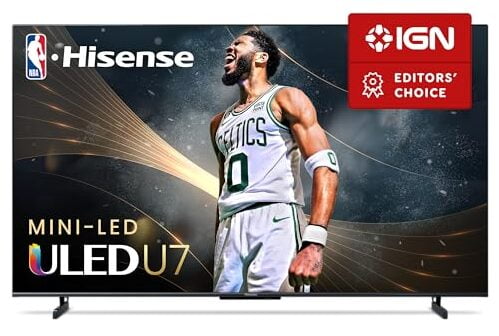
True Score
84859Experts
87521Customers
Absolutely Fresh
 SAVE $40$799.99$759.99
SAVE $40$799.99$759.99Snapshot
Reasons to Buy
- Outstanding picture quality in the dark
- High peak brightness
- Fast response time and low input lag
- 120 Hz refresh rate
Reasons to Avoid
- Subpar off-center viewing
- Average blooming
Specifications
Max Resolution 3840 x 2160 (4k) 
Backlight Type Full-Array Refresh Rate 120 Hz Display Type LED HDMI Inputs 4 
HDMI Type 2.0, HDMI 2.1 HDR Format Dolby Vision, HDR10, HDR10+, HLG 
HomeKit Compatible – 
Number of Audio Channels 2.1 
Panel Type IPS Screen size 55″, 65″, 75″ 
Smart Platform Google TV 
Speaker Output 40 Watts 
Sync Technology HDR Format 
VRR Yes All Specs
Test Results
SDR Brightness (nits) 603 HDR Brightness (nits) 786.5 Color Gamut % (DCI P3 xy) 96.31 Response Time (ms) 11.3 Contrast Ratio (x:1) 45,000 EOTF (600 nit delta) 0.0211 Color Gamut % (DCI P3 uv) 97.4 Color Gamut % (Rec 2020 xy) 76.18 Color Gamut % (Rec 2020 uv) 81.91 Color Gamut % (sRGB) 98.5 Color Gamut % (Rec 709) 0 Color Gamut % (BT.2020) 76 Color Gamut % (Adobe RGB) 80.5 Color Gamut % (BT.709) 0 Input Lag (ms) 14.3 Color Washout (Degrees) 23 Color Shift (Degrees) 23 Brightness Loss (Degrees) 35 Reflections (%) 1.9 Low-Freq Extension (Hz) 89.8 Freq Response StdDev @ 70db 4.36 Freq Response StdDev @ 80db 4.48 Weighted Total Harmonic Distortion @80db 0.096 Intermodulation Distortion @80db 4.47 EOTF (1000 nit delta) 0.021 EOTF (4000 nit delta) 0.013 All Tests
All Retailers
- $759.99$800Save $40
Availability
In StockFree Shipping
No - $790.00
Availability
In StockFree Shipping
No - $800.00
Availability
In StockFree Shipping
No
Our Verdict
If budget is what matters most, the Hisense U7K is one of the best value options on our list that also doesn’t skimp on performance. With its 96.31% DCI P3 color gamut, it delivers respectable color accuracy alongside a respectable contrast ratio over 45,000.
Brightness is where the U7K’s position as a value-oriented TV shows, with an SDR brightness of 603 nits and HDR at 786.5 nits. It beats OLEDs in SDR brightness and a couple of them in HDR, but it can’t match the HDR brightness of the more premium options or its higher-end brother, the U8K. Despite this, the U7K is plenty bright from nearly any kind of content as long as it’s not being used in a very bright room.
A response time of 11.3 ms and an input lag of 14.3 ms make the U7K a viable option for casual gaming and everyday viewing. It can’t quite cater to the highest demands of competitive gamers, but it’s more than enough for casual players and sports fans looking for smooth motion, responsive gameplay or a blend of the two, especially given that it often comes in at roughly a third of the price of some of the other options on this list.
In essence, the Hisense U7K stands out for its excellent value, offering a performance that punches above its weight class. Its combination of good color accuracy, adequate brightness, and decent response times make it a versatile and budget-friendly option in the 55-inch TV market. Whether you’re outfitting a living room, bedroom, or game room, the U7K offers a quality viewing experience that belies its affordable price point, making it an attractive choice for a wide audience.

Best Overall

Runner Up

Best Value

Best Budget

Best Mid-Range

Premium Pick
Hisense U8K TV
Offering exceptional brightness at a value price, the U8K is perfect for bright rooms and varied content, balancing performance and cost for those seeking dynamic visuals.
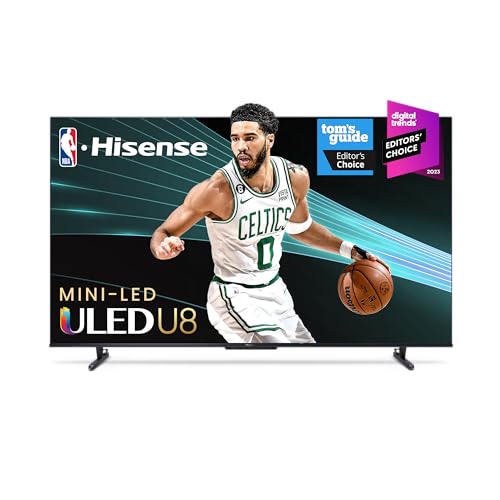
True Score
82816Experts
851kCustomers
Absolutely Fresh
 SAVE $102$799.99$698.00
SAVE $102$799.99$698.00Snapshot
Reasons to Buy
- Good picture quality
- Outstanding brightness and good contrast ratio
- Quick response time
- Great reflection handling
Reasons to Avoid
- Poor viewing angles
Specifications
Max Resolution 3840 x 2160 (4k) 
Backlight Type Full-Array Refresh Rate 144 Hz 
Depth 3″ Display Type LED HDMI Inputs (Total) 4 
HDMI Type HDMI 2.1 HDR Format Dolby Vision, HDR10, HDR10+, HLG 
Height 33.1″ High Dynamic Range (HDR) Yes 
Number of Audio Channels 2.1.2 
Panel Type VA Screen size 100″, 55″, 65″, 75″, 85″ 
Smart Platform Google TV 
Speaker Output 50 Watts 
Voice Assistant Google Assistant 
Weight 56.4″ lbs 
Width 57.2″ 
Works With Google Assistant All Specs
Test Results
SDR Brightness (nits) 1,549 HDR Brightness (nits) 1,792 Color Gamut % (DCI P3 xy) 97.44 Response Time (ms) 13.3 Contrast Ratio (x:1) 165,360 EOTF (600 nit delta) 0.0105 Color Gamut % (DCI P3 uv) 97.01 Color Gamut % (Rec 2020 xy) 76.18 Color Gamut % (Rec 2020 uv) 81.82 Color Gamut % (sRGB) 0 Color Gamut % (Rec 709) 0 Color Gamut % (BT.2020) 80 Color Gamut % (Adobe RGB) 0 Color Gamut % (BT.709) 0 Input Lag (ms) 14.2 Color Washout (Degrees) 23 Color Shift (Degrees) 23 Brightness Loss (Degrees) 35 Reflections (%) 1.8 Low-Freq Extension (Hz) 80 Freq Response StdDev @ 70db 2.06 Freq Response StdDev @ 80db 2.11 Weighted Total Harmonic Distortion @80db 0.1 Intermodulation Distortion @80db 0.71 EOTF (1000 nit delta) 0.0106 EOTF (4000 nit delta) 0.011 All Tests
All Retailers
- $698.00$800Save $102
Availability
In StockFree Shipping
Yes - $799.99
Availability
In StockFree Shipping
No Availability
Free Shipping
Our Verdict
The Hisense U8K TV stands out as a remarkable choice for anyone prioritizing performance and value. It shines with its exceptional brightness, boasting best-in-class SDR and HDR brightness of 1549 nits and 1792 nits, respectively. This makes the U8K unmatched for clarity and visibility in any room condition, from the brightest daylight to dimly lit spaces, ensuring a consistently vivid picture.
If you’re looking for incredible color accuracy on a budget, the 97.44% coverage of the DCI P3 color gamut means the U8K delivers rich, accurate colors for its price point.. When paired with the U8K’s 13.3 ms response time, it might not set records, but it’s more than sufficient to keep motion blur to a minimum for most content, from fast-paced sports to action-packed movies. Gamers will notice the 14.2 ms of input lag, putting it on the lower end of our list but it’s still plenty responsive for casual and light competitive gaming.
What makes the Hisense U8K compelling option as far as 55-inch TVs are concerned, is the incredible value it offers. It’s second-place for value (at the time of publishing), while delivering exceptional brightness and solid overall performance. This ability to deliver outstanding visibility in any lighting condition, coupled with good color accuracy and decent responsiveness, positions the U8K as a strong contender in the 55-inch TV market. If bright, dynamic visuals at LED prices are at the top of your list, the Hisense U8K is definitely worth considering.

Our Approach to Testing 55-inch TVs
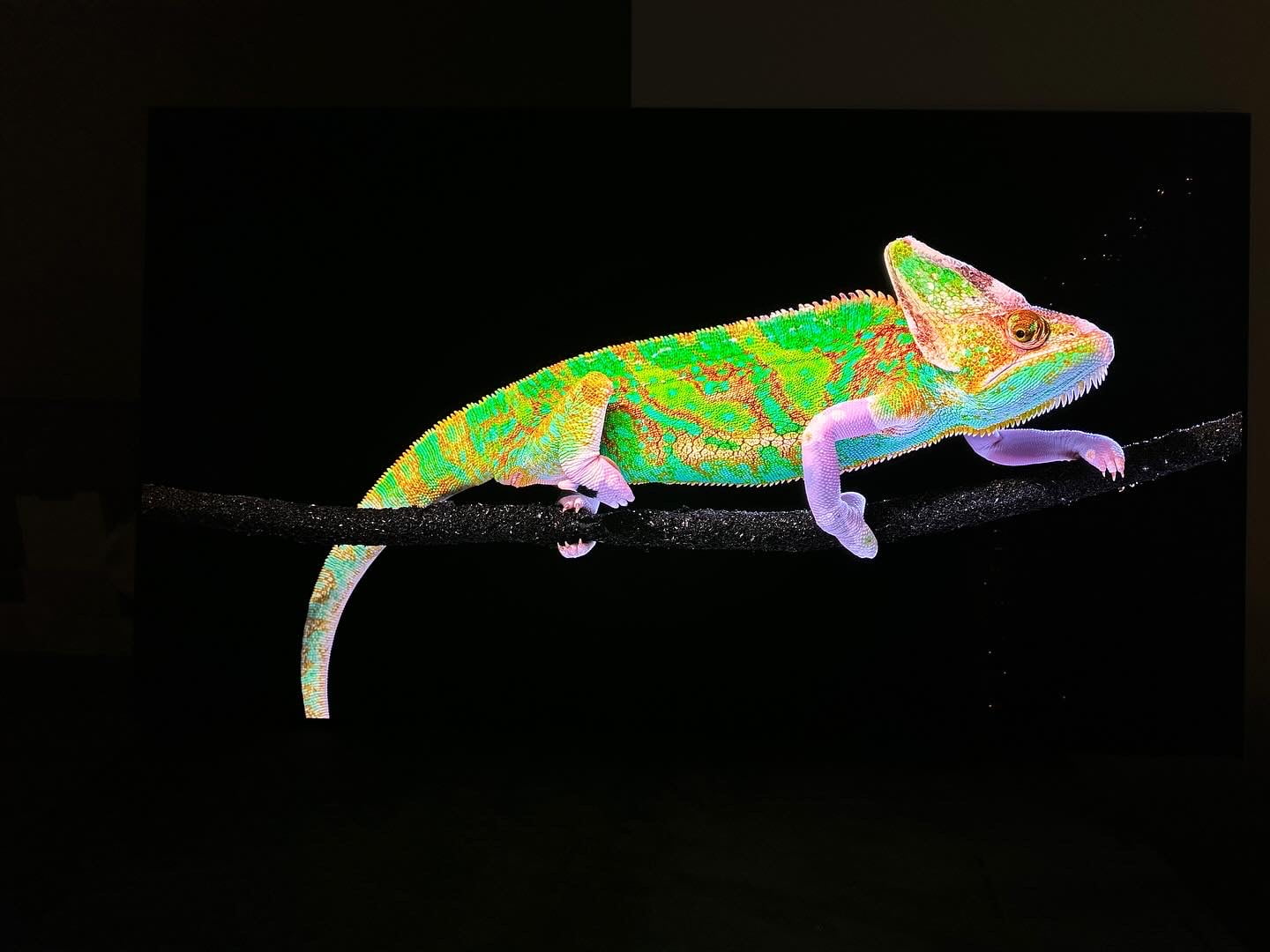
Evan Shepard/Gadget Review
We’ve redefined TV buying guides, setting us apart from any other site on the planet. Our unique approach combines in-house verification with a comprehensive dataset from trusted sites, focusing on key testing metrics like brightness (SDR and HDR), EOTF, response time, contrast ratio and color gamut.
We aggregate and analyze this data, ensuring our recommendations meet the specific needs. Specifically, when it comes to 55 Inch TVs, this involves selecting models that deliver optimal image quality for content, including the ability to upscale lower-resolution content effectively. Discover our data-driven methodology for precise, reliable TV recommendations.
You may notice some of our graphs contain “Source: RTings”. This is to indicate that the data we’re showing off in a graph has come from a single source – because it’s the only source that actually tested the criteria and had data for it! Normally, our data is an average out of all of the various publications that test and provide data to give you a good idea of how a product is going to perform on average.
Which Criteria Matters for Testing 55 Inch TV’s?
By focusing on these criteria (3 required, 3 nice to have), anyone can quickly and easily compare these TVs and how they’ll perform. This helps you make an informed decision and purchase a TV that will fit into space.
| CRITERIA | RANGE | REQUIRED | DEFINITION |
|---|---|---|---|
| SDR Brightness | 300+ nits | Yes | Assess the luminance of your display when operating in Standard Dynamic Range (SDR) mode. |
| HDR Brightness | 700+ nits | Yes | Determine the luminance of your display in High Dynamic Range (HDR) mode. |
| Color Gamut (DCI P3 xy) | >= 90% | Yes | Evaluate the extent to which a TV can reproduce a specified spectrum of colors. |
| EOTF | 0.018 | No (nice to have) | Standard that governs how a display interprets and renders brightness and color. |
| Response Time | <=10ms | No (nice to have) | Time required for a pixel to transition from one color to another and then return to its original color. |
| Contrast Ratio | >= 10,000 | No (nice to have) | The ratio between the brightest white and darkest black that the screen can display. |
Our Trusted Data Sources
(Publication category Score is 80%+)
We looked at 210+ TV reviewers and while 24 are trustworthy (60%+ Trust Rating), we only use data from the testers that are “very trusted” which means a Trust Rating above 70%. The three we have listed below are our most trusted for TVs, along with our own in-house TV expert.
- Evan Shepard – Gadget Review
- Matthew Lopes – RTings, MuckRack
- Will Greenwald – PCMag, MuckRack, Twitter
- David Katzmaier – CNET, MuckRack, Twitter
Interested in a comprehensive analysis of our data sources? We’ve got you covered. Below, you’ll find a detailed list of every TV review website we’ve identified, organized by their respective Trust Ratings from highest to lowest. But we didn’t stop there. We’ve meticulously reviewed each publication and verified the data by checking whether the authors have bio links to MuckRack or LinkedIn. We’re committed to not only checking the facts but ensuring their veracity.
Best 55 Inch TVs Test Data & Results
1. SDR & HDR Brightness TV Test Results
In well-lit rooms, the brightness level of your 4K TV, quantified in nits, is key to a great viewing experience. A TV that doesn’t meet the brightness requirement will struggle against natural and artificial light, resulting in a dim, lackluster image. Essentially, nits measure how well your TV can stand up to light interference, with higher values ensuring a sharper, more vivid display.
For standard viewing on the best 4K TV, you should look for at least 300 nits to strike the right balance between clarity and color quality in standard dynamic range (SDR) content. For high dynamic range (HDR) content, which offers richer colors and greater contrast, a minimum of 700 nits is ideal to truly appreciate the enhanced visuals. These brightness levels are recommended to ensure your TV performs well in bright settings, allowing you to enjoy your shows and movies without any loss in detail or quality. Aim for these minimums: SDR Brightness >= 300 nits; HDR Brightness >= 700 nits for the optimal experience.
Discover the top 4K TVs, ranked from brightest to least.
Brightness
SDR: 300+ nits
HDR: 700+ nits
Acceptable range of performance
Definition: Maximum brightness in a specified pattern size window. Most commonly measured in a 10% or 100% white window.
Units of Measurement: nits (alternatively cd/m²)
Tools to Measure: TV, luminance meter
Why It’s Important:
Brightness helps counter ambient light so that details and colors don’t wash out and get lost.
SDR Brightness (in nits, higher is better)
HDR Brightness (in nits, higher is better)
2. Color Gamut (DCI P3 xy) TV Test Results
Color Gamut
>= 90%
Acceptable range of performance
Definition: The TV’s capability to display a spectrum of colors.
Units of Measurement: % (color space coverage in percent)
Tools to Measure: Colorimeter
Why It’s Important:
Inaccurate colors compromise the authenticity of the content.
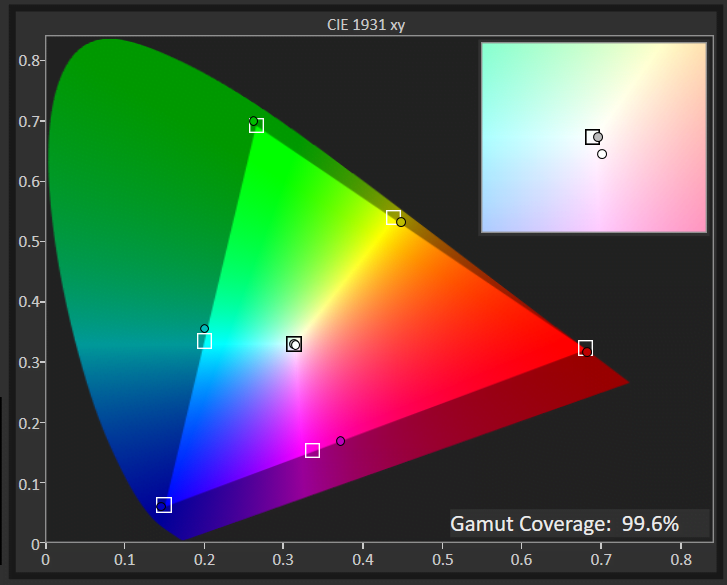
Color gamut defines the range of colors of a 55 Inch TV can reproduce, directly affecting how vibrant and true-to-life the images look. A wide color gamut in a TV brings out richer, more vivid colors – from the lush greens of a garden to the bright colors of animated characters, enhancing your viewing experience to closely mimic real life.
This concept is technically measured against standards like the DCI P3 xy, a benchmark for high-quality visuals. A 55 Inch TV covering a higher percentage of this color space can display colors more accurately and vividly.
For those who prioritize vibrant and immersive visuals, aiming for a 55 Inch TV with a color gamut of 90% or higher on the DCI P3 xy scale is ideal. This ensures that the content you watch is as vibrant and lifelike as possible.
Below are the top 55 Inch TVs, ordered by color gamut, all exceeding our testing criteria.
DCI P3 XY Color Gamut (as a %; high is better)
3. EOTF Test Results
The Electro-Optical Transfer Function (EOTF) plays a critical role in ensuring the content on your TV looks exactly as the creator intended. This technical feature adjusts your screen’s brightness levels, ensuring every scene, from the darkest shadows to the brightest highlights, is displayed with true-to-life accuracy.
In rooms flooded with light, a TV that nails EOTF calibration shines by preserving the intended contrast and detail in the picture despite the challenging conditions. It balances the brightness so that images remain vibrant and full of detail, unaffected by the glare of ambient light.
A TV that excels in managing EOTF offers an immersive and authentic viewing experience. It brings creators’ visions to life, accurately rendering every scene with the proper light and dark levels, no matter the lighting in your room. This means you get a consistent, realistic picture that captures the full spectrum of colors and contrasts, from the subtlest hues to the most intense explosions.
Below are all the 55 Inch TVs on our list, ordered by EOTF.
EOTF
< 0.018 (600 nit Δ)
Acceptable range of performance
Definition: How your TV interprets and renders the luminance data from content and translates it to be represented on screen. If EOTF/Gamma tracking is too low or too high, it will result in an over-brightened or over-darkened image from reference.
Units of Measurement: this test measures for the delta from the standard
Tools to Measure: Luminance colorimeter
Why It’s Important:
EOTF ensures that the game is displayed (color and HDR brightness) as the creator intended it
EOTF (source: rtings.com – 0 = no data exists; lower is better)
4. Response Time TV Test Results
Response Time
1ms-10ms
Acceptable range of performance
Definition: Speed at which a pixel transitions from one color to another
Units of Measurement: milliseconds (ms)
Tools to Measure: Screen, camera, test software
Why It’s Important:
A faster response time means less blur and thus more accuracy
A slow response time on a 55 Inch TV during fast-paced scenes is like trying to watch a thrilling movie with a foggy lens. Imagine settling in for an action-packed sequence, only to have the swift movements turn into a blur, robbing you of the crisp, clear detail you crave. This isn’t just a minor annoyance; it’s a major detriment to your viewing experience, leaving you with a picture marred by motion blur and visual artifacts.
So, what exactly is response time? It measures how quickly a pixel on your TV can change from one color to another. In the context of watching fast-moving content or enjoying dynamic scenes on a 55 Inch TV, a low response time is crucial. A response time of 15 ms or lower is good, but if you plan on gaming on this set, aim for a response time of 10 ms or lower. At these levels, your 55 Inch TV ensures smooth transitions and sharp visuals, making every scene come to life without any distracting blurs or delays.
Below are the top 55 Inch TVs, ordered by response time.
Response Time (in milliseconds; lower is better)
5. Contrast Ratio Test Results
For 55 Inch TV enthusiasts, a solid contrast ratio is crucial for enjoying your favorite TV shows or movies, especially in darker settings. This feature directly impacts how lifelike and dynamic the picture appears on your screen, ensuring that dark scenes are displayed with clear, crisp blacks instead of murky grays and bright scenes retain their detail without appearing washed out.
Put simply, the contrast ratio is all about the range of luminance a TV can produce, from the deepest blacks to the brightest whites. It’s what brings depth to the image, enhancing the realism of every scene. Watching a movie in the dark, for example, the difference between a TV with a poor contrast ratio and one with a high ratio is stark: the former struggles, blending shadows into a flat gray, while the latter delivers true black, making night scenes more immersive and detailed.
Ideally, a contrast ratio of 10,000:1 is what you should aim for in a 55 Inch TV. This level of luminance variance ensures that you’re getting a picture quality that can handle the nuances of lighting in any scene, providing a viewing experience that’s both rich and engaging. Note: OLED TVs have infinite contrast ratio, indicated by “0.”
Below are the top 55 Inch TVs, ordered by contrast ratio, all exceeding our testing criteria.
Contrast Ratio
>=10,000:1
Acceptable range of performance
Definition: Difference between the darkest black and the brightest white a screen can display.
Units of Measurement: cd/m2
Tools to Measure: Luminance meter
Why It’s Important:
A higher contrast ratio delivers deeper blacks, enhancing content definition, especially in darker rooms.
Contrast Ratio (higher is better)
55 Inch TVs: Mistakes To Avoid
- Ignoring Viewing Distance: Failing to consider the optimal viewing distance for a 55-inch TV can result in discomfort or diminished picture quality. If your living space allows for more distance between the couch and TV, consider upgrading to a larger screen such the top 65-inch TV to enhance your viewing experience.
- Overlooking Display Technology: Not researching or understanding the differences between various display technologies (e.g., OLED, QLED, LED) can lead to dissatisfaction with picture quality. For instance, the best OLED TVs are known for their superior contrast ratios and perfect blacks, which can significantly enhance your viewing experience with more vivid and lifelike images.
- Ignoring Connectivity Needs: Not assessing the number and types of ports needed for devices like gaming consoles, sound systems, or streaming devices can limit usability. When selecting the best gaming TVs, ensuring adequate HDMI 2.1 ports is crucial for the latest consoles to take full advantage of their capabilities, including higher frame rates and resolutions. Additionally, if you plan to connect a soundbar to your TV, you need to ensure that you have enough HDMI ports for it and any other components you want to connect.
- Neglecting Picture Quality Specifications: Overlooking important specifications such as TV’s resolution, HDR support, refresh rate, and color accuracy can result in a subpar viewing experience. To ensure you can enjoy your favorite teams with the best picture quality, check out the top TVs for sports.
The Best 55 Inch TVs Tests Compared
Product |
True Score
|
SDR Brightness
|
HDR Barightness
|
Color Gamut
|
EOTF
|
Response Time
|
Contrast Ratio
| |
|---|---|---|---|---|---|---|---|---|
| 92 |
|
|
|
|
|
| $1,097.95 $1,295 $197 |
| 89 |
|
|
|
|
|
| $1,379.00 |
| 89 |
|
|
|
|
|
| $879.99 $1,297 $417 |
| 88 |
|
|
|
|
|
| $1,094.00 $1,237 $143 |
| 84 |
|
|
|
|
|
| $759.99 $800 $40 |
| 82 |
|
|
|
|
|
| $698.00 $800 $102 |

